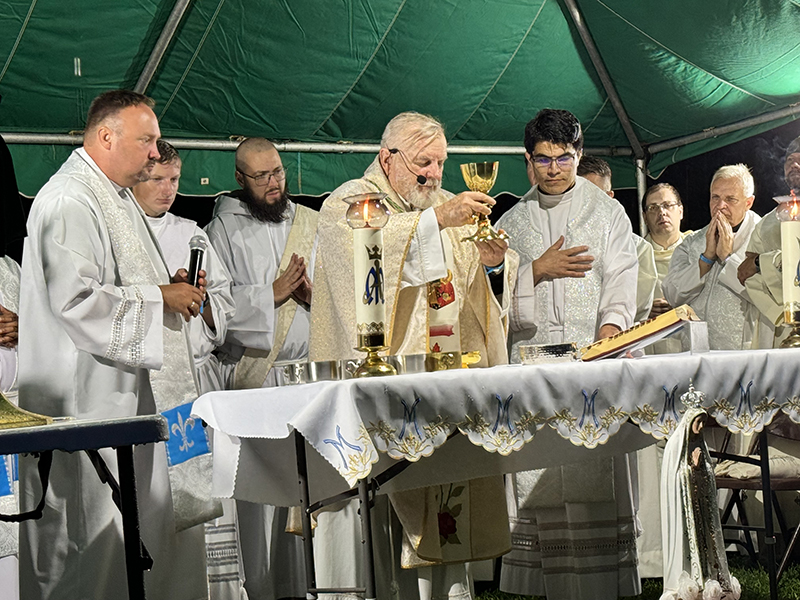By Archbishop Thomas Wenski - The Archdiocese of Miami

Archbishop Thomas Wenski celebrates Mass at the end of the first day of the walking pilgrimage on August 8, 2024. The four-day walking pilgrimage began at Sts. Peter and Paul Church in Great Meadows, NJ. and ended Sunday, August 11, at Our Lady of Czestochowa Shrine in Doylestown, PA.
On August 7, together with five of our seminarians, our vocations director, Father Milton Martinez and my priest secretary, Father Agustin Estrada, and I flew to New Jersey to participate in a four-day walking pilgrimage through back roads of New Jersey to the Marian Shrine of Our Lady of Czestochowa in Doylestown, Pennsylvania. It was a trek of almost 60 miles, and it wasn’t easy.
Almost 2,000 people participated – mostly Poles who continue here in America this tradition of their native Poland – but such a pilgrimage, in the heat and rain, sleeping in tents with no showers or flushing toilets, is a kind of “walking retreat.” (Actually – full disclosure – Father Martinez, Father Estrada and myself commuted to showers and beds at the Shrine monastery each night). But this “walking retreat” during which we sang, prayed, and engaged in serious conversation with one another while enduring the hardships of sore feet, aching muscles, and the heat and humidity of summer in August was undertaken precisely to remind ourselves that we all are pilgrims on this earth. And often our earthly pilgrimage finds us as “poor banished children of Eve,” “mourning and weeping in this valley of tears”.
Our vocation – the reason we are put on this earth – is to journey to heaven. And it is not necessarily an easy journey. But God, who created us in His own image and likeness, did not create us just to die one day, but He made us for Himself. To go to heaven is to go to God, to live with God.
On August 15th we celebrated the Solemnity of the Assumption, the day of Mary’s birth in heaven, and the end of her earthly pilgrimage. Pope Pius XII expressed the constant belief of the Church when in 1950 he solemnly defined the dogma of the Assumption of the Blessed Virgin Mary in these words: "…the Immaculate Virgin, preserved free from all stain of original sin, when the course of her earthly life was finished, was taken up body and soul into heavenly glory, and exalted by the Lord as Queen over all things, so that she might be the more fully conformed to her Son, the Lord of lords and conqueror of sin and death.” (CC#966)
The trajectory of Mary’s life was always “God-ward.” Full of grace from the very moment of her conception, Mary Immaculate never ceased to grow in grace before God. Her pilgrimage did not know some of the detours or even U-turns that we sinners oftentimes take in our own pilgrimages. Today, in this era of heightened individualism and narcissism, when the idea of human autonomy is invoked to justify the killing of life in the womb, Mary’s example – and her intercession – can help us to move from self-centeredness to being more “God-centered.”
With Baptism we are incorporated into Christ and come to share in His Risen Life. In the pilgrimage of risen people whom Christ brings with him to heaven, Mary goes first, with Christ and for Christ. But Mary’s vocation is the Church’s vocation. In the vivid imagery of the Book of Revelation, as the woman clothed in the sun, she represents us – and she precedes us.
The Assumption, then, celebrates Mary, but it also consoles us – for in taking Mary Body and Soul into Heaven, God assures us that He keeps his promises. The affirmation we make in the Creed is not just wishful thinking: “I believe in the resurrection of the body and the life everlasting.” Such an affirmation of faith is believable; it is credible because it has been promised to us by someone who is trustworthy. We believe in the promise because it is Jesus who has promised us; and we believe because, in Mary, the promise has already been kept.
That promise kept us walking towards the Shrine of Our Lady of Czestochowa, where we prayed that when our life’s pilgrimage comes to an end, Mary would show us in heaven “the blessed fruit of her womb: Jesus”.

